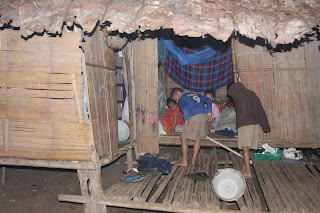During the Christmas 2009 break, Debbie and I visited an orphanage along the Thai-Burmese border in the northern part of Thailand. Our Foundation has recently built water towers to collect and store water for the children throughout the year for this orphanage. Our trip to this area was to visit several orphans who are currently sponsored by the Foundation. These children are from Karen tribes who are refugees from Burma.
It all began about 15 years ago, when Mrs. Tasanee Keereepraneed received a frantic message from a local villager in Tha Song Yang, which is about 3 hours north of Mae Sot province on the Thai-Burmese border, that a little girl had lost her mother during birth. In Karen culture this is interpreted as a bad omen, and the child is often killed. Having lost her own father at a young age and her children also having lost their father when Tasanee’s husband was murdered, Tasanee decided that she, if anyone should be the person responsible for caring for the orphaned children of The Karen. Tasanee now has 48 children to care for in the Tha Song Yang facility and several children go to school in Mae Sot for education beyond grade 10.
The orphanage, consisting of several huts is located next to the Moei River, and is surrounded by jungle and beautiful limestone mountains. Before the water tower was built, water was carried from the stream daily to provide for the needs. The children now have access to safe drinking water as well as for all their other necessary requirements all year around.
During this trip we also met two Karen children, who are orphans and recently brought to the orphanage. 14-year-old Corde and her brother 8-year-old Nataphong. Both witnessed their mother being beaten to death by their step father in a village near the border. They are mentally disturbed. Our Foundation has agreed to look after their welfare and education.
There are many refugee camps along the Thai-Burmese border. It is sad the Karen tribes had to flee from their land in Burma. Every dry season bring fresh offensives by the Burmese regime and new waves of refugees fled to Thailand. Today there are more than 140,000 refugees housed in nine camps along the border. Majority of the refugees are from Karen tribes, but also including some minority tribes, such as Mon, Karenni and Shan. These people have fled the fighting and abuses by the military in their homeland.







Comments